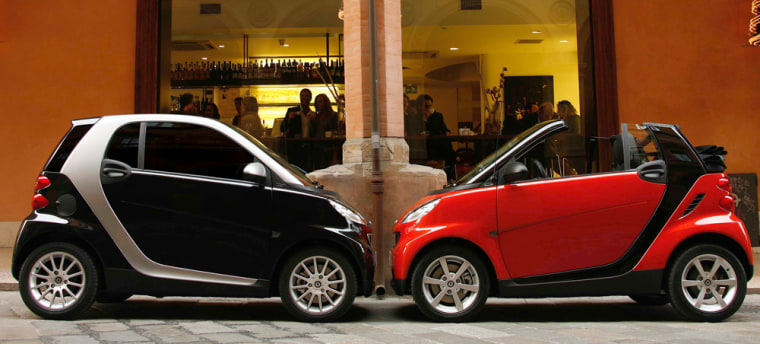At just 8 feet, 8 inches long and about 5 feet wide, the two-seat Smart car turned heads as it rolled through Manhattan one recent evening at rush hour.
Pedestrians in Times Square gawked. In front of Grand Central Terminal, a cabbie rolled down his window and asked, "What is it? How much?" Two nearby police officers both gave it a thumbs up.
The 1,800-pound "micro-car" — more than 3 feet shorter than fellow European pipsqueak the Mini Cooper — is likely to be the smallest thing on four wheels when it hits the U.S. car market in early 2008. Produced in France by the Mercedes Car Group, the "Fortwo" model has been on a 50-city U.S. tour this summer, including Detroit, Smart USA's corporate headquarters.
Its base price is $12,000, and it's hard to beat the fuel efficiency of about 40 miles per gallon. If any car can squeeze into Manhattan parking spots, this is it. And Smart is hip: The Museum of Modern Art has displayed it as an innovative, stylish solution to two practical problems: urban crowding and diminishing energy.
But the big question is: How many Americans, used to SUVs and other hefty vehicles, will take to this itty bitty car? Is it safe?
"Just how many urban fashionistas are there?" wrote Juergen Zoellter in a review this spring for Car and Driver magazine, predicting only limited U.S. sales. He said the prospect of driving a Fortwo in truck traffic on American highways was "scary."
"In the States, the vehicle's size may work against it," he wrote.
Waiting for crash tests
The Smart car's U.S. crash-test results will be announced this fall, said David Schembri, president of Smart USA and a veteran auto marketing executive, previously with Mitsubishi. He said it's expected to get four stars out of a possible five.
The European New Car Assessment Program crash-tested a previous model, the Smart City Coupe, and gave it a three-star rating out of a possible five. The U.S. model is almost 8 inches longer than the European one, with safety improvements including a steel safety "cage" inside, more air bags, and "intelligent" seatbelts that sense motion changes.
Of course, once outside the cage, there's not a whole lot of car left.
"Even with modern safety features like multiple air bags, people in small, light cars are always at a disadvantage in crashes," said Russ Rader of the Arlington, Va.-based Insurance Institute for Highway Safety.
The United States is way behind the rest of the world in embracing small, fuel-efficient cars. But even abroad, the Smart car has not been profitable. With about 750,000 cars sold in 36 countries, the company reportedly has lost billions of dollars. Last year, sales fell to 102,700 vehicles worldwide from 124,300 in 2005.
Still, more than 20,000 wannabe Smart owners in the United States have already signed up.
Schembri calls it "the wow factor."
The Smart car "challenges habits of personal mobility," said a MoMA tag for a 2002 display of the vehicle. In August, the little car was taken for test drives at East Hampton, N.Y., playground of the hungry-for-novelty rich. Commercials for the Nintendo Wii, meanwhile, a video game system, have featured a Smart in white with sky blue accents, mirroring the game's colors.
Even at 6-foot-1 and "not skinny," Schembri said he fits comfortably behind the wheel. The quick-handling vehicle, with a more than 70-horsepower, 1-liter, three-cylinder engine, is "so much fun to drive it's addictive," he said.
Moving parts
The Smart car began in the early 1990s, when Nicolas Hayek, inventor of the Swatch watch, went to Mercedes-Benz with his idea for an "ultra-urban" car with interchangeable body panels for style and color — a feature similar to the trendy Swiss watch. The prototype of the Smart City Coupe was introduced in Germany in 1997.
Swatch is no longer involved with the car, but the "S" in Smart still stands for Swatch, the "m" for Mercedes, and the "art" for, well, the artsy combos that are options.
For instance, it can come as a "cabriolet" (French for convertible), or if an owner gets tired of the color, the body panels — made of recycled plastic — can be removed and switched.
In addition, the same Smart car can be driven either stick shift or automatic. Gears are changed using either the traditional floor "stick," or by squeezing levers under the steering wheel — right to shift up, left to shift down.
One fancier version, starting at $14,000, includes air conditioning, alloy wheels and a panoramic roof. The convertible, starting at about $17,000, features an upgraded sound system with MP3 capability and a six-disc CD changer.
The target U.S. market, said Schembri, includes first-time car buyers, urban sophisticates, baby boomers looking for a second car, and "empty-nest" parents.
The first U.S. Smart car dealerships will be announced later this year, with sales and service handled by Smart USA, a division of the Penske Automotive Group, which is distributing the car in North America and Puerto Rico.
